Related Research Articles

The Central line is a London Underground line that runs through central London, from Epping, Essex, in the north-east to Ealing Broadway and West Ruislip in west London. Printed in red on the Tube map, the line serves 49 stations over 46 miles (74 km), making it the longest line on the Underground. It is one of only two lines on the Underground network to cross the Greater London boundary, the other being the Metropolitan line. One of London's deep-level railways, Central line trains are smaller than those on British main lines.

Blake Hall is a disused former station on the London Underground in the civil parish of Stanford Rivers, and south from the village of Bobbingworth in Essex. It was latterly on the Central line, between North Weald and Ongar, but was originally served by the Epping to Ongar shuttle service branch line.
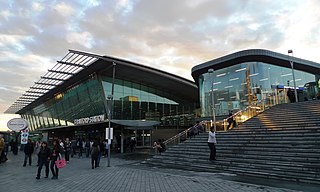
Stratford is a major multi-level railway station which rates as the fifth busiest station in Britain, serving the district of Stratford and the mixed-use development known as Stratford City, in the London Borough of Newham, east London. It is served by the London Underground, London Overground, Docklands Light Railway (DLR) and is also a National Rail station on the West Anglia Main Line and the Great Eastern Main Line, 4 miles 3 chains (6.5 km) from Liverpool Street. It is also the busiest station on the Tube network outside Travelcard Zone 1.

Rayners Lane is a London Underground station in the district of Rayners Lane in north west London, amid a 1930s development originally named Harrow Garden Village. The station is on the Uxbridge branch of both the Metropolitan line, between Eastcote and West Harrow stations, and the Piccadilly line, between Eastcote and South Harrow stations. The station is located to the west of the junction of Rayners Lane, Alexandra Avenue and Imperial Drive (A4090). It is in Travelcard Zone 5. Just east of the station, the Piccadilly and Metropolitan lines tracks join for services to Uxbridge and separate for those to Central London.

Henry Charles Beck was an English technical draughtsman who created the present London Underground Tube map in 1931. Beck drew the diagram after being fired at the London Metro Signal Office. Although his design was initially rejected, the Publicity Office of London Transport changed their minds after Beck resubmitted an updated copy and the map was first issued as a pocket edition in January 1933. It was immediately popular, and the Underground has used topological maps to illustrate the network ever since. Harry Beck wanted to make the network easier to understand by colouring each train route and using straight lines and 45 degree angles.

The British Rail Class 482 electric multiple units were built by ABB in 1992, for use on the Waterloo & City line. The units are almost identical to the 1992 tube stock built for the Central line.
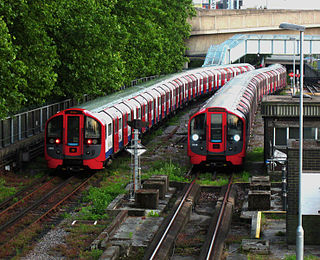
London Underground rolling stock includes the electric multiple-unit trains used on the London Underground. These come in two sizes, smaller deep-level tube trains and larger sub-surface trains of a similar size to those on British main lines, both running on standard gauge tracks. New trains are designed for the maximum number of standing passengers and for speed of access to the cars.
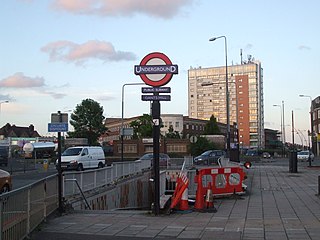
Gants Hill is a London Underground station in the largely residential Gants Hill district of Ilford in East London. It is served by the Central line and is between Redbridge and Newbury Park stations on the Hainault loop. It is in Travelcard Zone 4. It is the easternmost station to be below ground on the London Underground network and the busiest on the Hainault loop.

The history of the London Underground began in the 19th century with the construction of the Metropolitan Railway, the world's first underground railway. The Metropolitan Railway, which opened in 1863 using gas-lit wooden carriages hauled by steam locomotives, worked with the District Railway to complete London's Circle line in 1884. Both railways expanded, the Metropolitan eventually extending as far as Verney Junction in Buckinghamshire, more than 50 miles (80 km) from Baker Street and the centre of London. The first deep-level tube line, the City and South London Railway, opened in 1890 with electric trains. This was followed by the Waterloo & City Railway in 1898, the Central London Railway in 1900, and the Great Northern and City Railway in 1904. The Underground Electric Railways Company of London (UERL) was established in 1902 to fund the electrification of the District Railway and to complete and operate three tube lines, the Baker Street and Waterloo Railway, the Charing Cross, Euston and Hampstead Railway and the Great Northern, Piccadilly and Brompton Railway, which opened in 1906–07. By 1907 the District and Metropolitan Railways had electrified the underground sections of their lines.
A wrong-side failure describes a failure condition in a piece of railway signalling equipment that results in an unsafe state. A typical example would be a signal showing a 'proceed' aspect when it should be showing a 'stop' or 'danger' aspect, resulting in a "false clear".
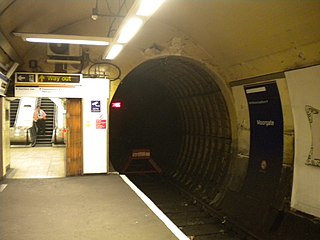
The Moorgate tube crash occurred on 28 February 1975 at 8:46 am on the London Underground's Northern City Line; 43 people died and 74 were injured after a train failed to stop at the line's southern terminus, Moorgate station, and crashed into its end wall. It is considered the worst peacetime accident on the London Underground. No fault was found with the train, and the inquiry by the Department of the Environment concluded that the accident was caused by the actions of Leslie Newson, the 56-year-old driver.

The Harrow and Wealdstone rail crash was a three-train collision at Harrow and Wealdstone station in Wealdstone, Middlesex during the morning rush hour of 8 October 1952. The crash resulted in 112 deaths and 340 injuries, 88 of these being detained in hospital. It remains the worst peacetime rail crash in British history and the second deadliest overall after the Quintinshill rail disaster of 1915.

On the evening of 4 December 1957, two trains crashed in dense fog on the South Eastern Main Line near Lewisham in south-east London, causing the deaths of 90 people and injuring 173. An electric train to Hayes had stopped at a signal under the bridge, and the following steam train to Ramsgate crashed into it, destroying a carriage and causing the bridge to collapse onto the steam train. The bridge had to be completely removed; it was over a week before the lines under the bridge were reopened, and another month before the bridge was rebuilt and traffic allowed over it.
The railway infrastructure of the London Underground includes 11 lines, with 272 stations. There are two types of line on the London Underground: services that run on the sub-surface network just below the surface using larger trains, and the deep-level tube lines, that are mostly self-contained and use smaller trains. Most of the lines emerge on the surface outside the Central London area.
The transport system now known as the London Underground began in 1863 with the Metropolitan Railway, the world's first underground railway. Over the next forty years, the early sub-surface lines reached out from the urban centre of the capital into the surrounding rural margins, leading to the development of new commuter suburbs. At the turn of the nineteenth century, new technology—including electric locomotives and improvements to the tunnelling shield—enabled new companies to construct a series of "tube" lines deeper underground. Initially rivals, the tube railway companies began to co-operate in advertising and through shared branding, eventually consolidating under the single ownership of the Underground Electric Railways Company of London (UERL), with lines stretching across London.

The Southbury Loop is a line linking Edmonton Green, in north-east London, to Cheshunt. It was opened by the Great Eastern Railway in 1891 although initially it was not very successful and was closed to passenger traffic in 1909. Goods trains continued to use the line although in World War I passenger services were reinstated for munitions workers. Once the war finished the line returned to its goods-only role although was occasionally used for diversionary purposes when the West Anglia Main Line was closed south of Cheshunt. Electrification of the line and the reintroduction of passenger services in 1960 saw the line become busy with regular suburban services as part of the Lea Valley Lines network. Since May 2015 passenger services on the line are part of London Overground.

Although the railway network in Great Britain has some of the smallest loading gauges in the world, the vast bulk of it is still capable of operating full sized vehicles. However, British Rail, together with its predecessors and successors have, on occasion, been required to operate passenger trains to an even smaller loading gauge and have, as a consequence, obtained rolling stock identical to that of the "deep tube" lines of London Underground; these are lines built using the tunneling shield method, that were, by necessity, smaller than those lines built using the cut-and-cover method. In 1892, a Parliamentary Committee headed by James Stansfeld recommended that such lines be in tunnels with a minimum diameter of 11 ft 6in. Two routes operated by British Rail required the use of such deep-tube rolling stock, the Waterloo & City Line in London, and the Island Line on the Isle of Wight.
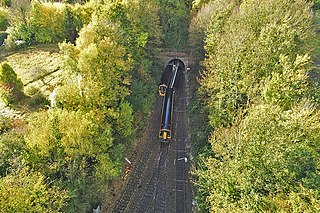
The Salisbury Rail Crash was a railway accident on 31 October 2021, at Salisbury, Wiltshire, United Kingdom. Two trains, travelling on converging lines, collided at Salisbury Tunnel Junction, approximately one mile northeast of Salisbury railway station. Fourteen people, including one of the train drivers, were taken to hospital.
References
- ↑ Croome, Desmond F.; Jackson, Alan A. (1993). Rails through the clay: a history of London's tube railways (2nd ed.). Harrow Weald: Capital Transport. p. 286. ISBN 978-1-85414-151-4.
- ↑ Croome, Desmond F.; Jackson, Alan A. (1993). Rails through the clay: a history of London's tube railways (2nd ed.). Harrow Weald: Capital Transport. pp. 287, 291. ISBN 978-1-85414-151-4.
- 1 2 McMullen, D.; London Transport Executive (October 1953). Ministry of Transport (ed.). Report on the Collision which occurred on 8th April 1953 near Stratford on the Central Line (PDF). Railway Accidents (Report). Her Majestry's Stationery Office.
- 1 2 3 "Plaque unveiled to remember victims of Stratford Tube crash". Newham Recorder. 13 April 2016. Retrieved 26 July 2023.
- Railways Archive account, including official Accident Report
- Railways Archive account and Accident Report of 1946 accident
- Rolt, L.T.C.; Kichenside, Geoffrey M. (1982) [1955]. Red for Danger (4th ed.). Newton Abbot: David and Charles. pp. 281–282. ISBN 0-7153-8362-0.